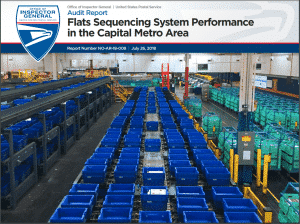 August 13, 2018
August 13, 2018
Nearly a decade since its rollout, the Flats Sequencing System (FSS) — the football-field sized sorting machines for flats mail — is still falling short of expectations. At its inception, stakeholders were optimistic FSS would improve productivity and reduce the U.S. Postal Service’s costs for handling flats mail.
But, declines in flats mail volume over the past decade have inhibited the Postal Service’s ability to meet FSS throughput goals. Flats mail volume has dropped by almost 10.3 million pieces — or 46 percent — since initial FSS deployment in 2008. Given this volume decline, the Postal Service in 2010 reduced its FSS throughput goals by about 30 percent.
Yet even with the reduced goals, the FSS appears to be falling flat of expectations.
 We evaluated FSS performance in the Capital Metro Area and found the average daily volume over a one-year period in FY 2017 was about 46 percent below the per-day goal of 195,500 mailpieces. The machines were also about 4.5 hours below the average daily runtime goal of 17 hours per machine. Management acknowledged that insufficient flats volume kept them from meeting FSS throughput goals.
We evaluated FSS performance in the Capital Metro Area and found the average daily volume over a one-year period in FY 2017 was about 46 percent below the per-day goal of 195,500 mailpieces. The machines were also about 4.5 hours below the average daily runtime goal of 17 hours per machine. Management acknowledged that insufficient flats volume kept them from meeting FSS throughput goals.
In addition, we found about 23 percent of flats mail intended for FSS was being processed elsewhere, much of it on the Automated Flats Sorting Machine (AFSM). This “leakage” requires additional manual sorting by the letter carrier. Manual processing drives up costs and doesn’t allow the FSS to capture savings as anticipated, earlier OIG work determined.
Our review found that because USPS does not manage leakage, it can’t identify the cause.
More troubling, however, is that it’s unclear whether processing flats on FSS machines is more cost-efficient than using AFSM. The Postal Service does not have any current studies or analyses to establish the financial benefit or workhour savings achieved when flats mail is processed on the FSS vs. the AFSM.
We recommended USPS track and address the causes of leakage and determine the operational costs and savings the FSS currently provides to fully understand its financial and operational impacts.
Source: USPS Office of Inspector General
